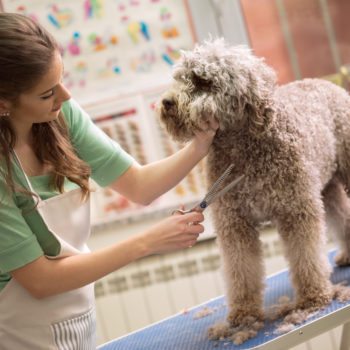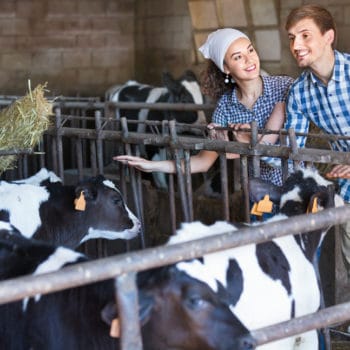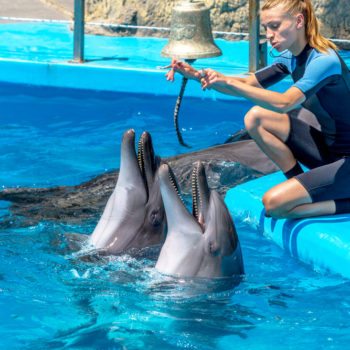Why We Love It
-
$23,630Potential Avg. Salary
-
10.5%Job Growth Rate
-
Growing DemandJob Outlook
-
High Job SatisfactionCareer Attribute
Dog or pet sitters care for pets when their owners are away. They may work in kennels or doggy day cares, or they may care for pets in client’s homes. They ensure pets are fed, watered, and walked, and they play with and comfort pets to ensure the burden of being away from owners is minimal.
Recommended Schools
What is a Dog or Pet Sitter?
The following job responsibilities are common for individuals in dog or pet sitter roles:
- Care for dogs and other pets while owners are away
- Ensure pets receive all necessary care, including food, water, baths, and exercise
- Play with and attend to pets to minimize the emotional impact of an owner being away
- Monitor pets for signs of illness or injury, and take pets to veterinarians if needed
- Care for pets in a kennel, doggy day care, or in clients’ homes
A Day in the Life
When pet owners must leave their homes—either for work or vacation—they must either take pets with them or find someone to care for their pets in their absence. While traveling with pets is possible, it is often impractical or difficult to find pet-friendly transportation and accommodations. For this reason, pet owners—especially dog owners—often employ pet sitters to care for their pets while they’re away. Pet sitters take care of pets on behalf of their owners when owners are unavailable to provide care.
Dog and pet sitters perform all of the same tasks an owner would when caring for a pet. They feed and water pets at certain intervals throughout the day, take pets for walks, and give them attention so that they feel safe without their owners. They may also give pets baths if needed, and they monitor pets for signs of illness or injury. If issues arise, pet sitters notify their clients, and they may need to take pets in for veterinarian appointments to receive treatment or medication.
While pet sitters most commonly take care of dogs, they may also take care of other types of pets: cats, birds, fish, and more exotic pets like amphibians. The tasks pet sitters need to perform vary greatly by the type of pets they’re caring for. Some pet sitters may take care of multiple pets at the same time at a kennel or doggy day care, while others care for pets individually in owner’s homes. When sitting cats, fish, or amphibians, pet sitters may simply need to check in a few times a day rather than staying in the home with the pets.
Typical Work Schedule
Dog and pet sitters must be available to care for pets’ needs 24 hours a day while owners are away, so a job as a pet sitter may require irregular working hours and weekend/holiday work. Both full- and part-time schedules are commonly available.
Projected Job Growth
The number of households that own pets has been consistently increasing over the years, and the growth in pet ownership will create an increased demand for pet sitters in the coming decade to care for pets while owners are out of town or otherwise unavailable.
Pet Sitter Specializations
Most pet sitters care for dogs, though they may check in on cats while owners are away. Additionally, they may care for more exotic pets in an owner’s absence, such as birds, fish, or amphibians. Pet sitters who care for more exotic pets may need specialized training to care for pets with special or unusual needs.
Typical Employers
Some pet sitters are self-employed and take on individual clients on a freelance basis. These pet sitters commonly stay in owners’ homes while they’re away and take care of pets in their normal environment. Other pet sitters may work for kennels, doggy day cares, or pet stores that offer kenneling services.
Recommended Schools
How To Become a Dog or Pet Sitter
No formal postsecondary education is needed to become a pet sitter, so a high school diploma is usually a sufficient credential for finding work in this career field. What is more important for successfully breaking into the field of pet sitting is experience and detailed knowledge of how to care for the types of pets you plan to sit for. This knowledge and experience can come from a variety of sources, including simply owning and caring for pets of your own. Well cared for personal pets can be ample evidence of your ability to care for pets efficiently.
However, many pet owners will want pet sitters to provide references. References prove that you’re trustworthy as a pet caretaker as well as a houseguest. To accrue some professional references, you can volunteer your time to care for the pets of friends, family members, and coworkers while they’re out of town. In exchange for caring for their pets for free, you can ask them to serve as a reference for your abilities to future clients.
Other ways to gain experience working with and caring for pets is by volunteering to work in an animal shelter, or taking a job at a pet store performing some tasks related to pet care. Additionally, you can take a home-study course offered by either the National Association of Professional Pet Sitters or Pet Sitters International to become certified as a pet sitter to further increase your credibility as an effective dog or pet sitter.
Dog or Pet Sitter Salary Data
We’ve provided you the following to learn more about this career. The salary and growth data on this page comes from recently published Bureau of Labor Statistics data while the recommendations and editorial content are based on our research.
National Anual Salary
Low Range
$18,580Average
$23,630High Range
$34,780National Hourly Wage
Low Range
$9/hrAverage
$11/hrHigh Range
$17/hrHow do Dog or Pet Sitter salaries stack up to other jobs across the country? Based on the latest jobs data nationwide, Dog or Pet Sitter's can make an average annual salary of $23,630, or $11 per hour. This makes it an Above Average Salary. On the lower end, they can make $18,580 or $9 per hour, perhaps when just starting out or based on the state you live in.
Salary Rankings And Facts
#785 Nationally for All Careers
Highest Education Among Dog or Pet Sitters
- 0.9% Doctorate
- 2.4% Masters
- 16.3% Bachelors
- 8.3% Associates
- 27.2% College
- 34.7% High School
- 10.2% Less than High School
Job Growth Projections and Forecast
2014 Total Jobs
204,8002024 Est. Jobs
226,400Job Growth Rate
10.5%Est. New Jobs
21,600How does Dog or Pet Sitter job growth stack up to other jobs across the country? By 2024, there will be a change of 21,600 jobs for a total of 226,400 people employed in the career nationwide. This is a 10.5% change in growth over the next ten years, giving the career a growth rate nationwide of Below Average.
Growth Rankings And Facts
#172 Nationally for All Careers
What Companies Employ The Most Dog or Pet Sitters
| Industry | Current Jobs | New Jobs Needed | % Increase |
|---|---|---|---|
| Other personal services | 67,900 | 11,800 | 12% |
| Self-employed workers | 39,200 | 3,400 | 3% |
| Other miscellaneous store retailers | 28,400 | 700 | 1% |












